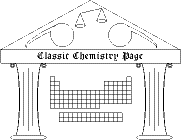Arrhenius kinetics
In attempting to quantify the dependence of reaction rates on temperature, Arrhenius examined several sets of reaction rate data taken at various temperatures. The investigators who collected these data proposed functional forms to represent the observed temperature dependences. Arrhenius found that all of the data sets could be represented adequately by an expression equivalent to what we now call the Arrhenius equation.
The sets of data Arrhenius reviewed appear below the exercises. (Or download a spreadsheet file containing the data by clicking here.) Each set is lettered and identified by the name of the investigator(s) and a description of the reaction. There appears to be a typographical error in one of the rates in set c (Urech's data). That error is the subject of exercise 2.
1) Use the Arrhenius equation in the form,
rate = Ae-E/RT ,
to find the activation energy of the following reactions. (Of course the Arrhenius equation is usually written for the rate constant rather than the reaction rate, but the data appear to be rates, in unknown units, rather than rate constants.) This can be done by plotting ln rate vs. 1/T (where T is the Kelvin temperature) and finding the equation of the best-fit straight line. Take the natural log of the above equation to see how the activation energy E is related to the slope or intercept of the best-fit line.
2) One of the rates printed in set c (Urech's data) appears to have a typographical error. In particular, one of the rates appears to be off because of a misplaced decimal. (Such errors, in which a zero is omitted or added or a decimal point moved are not unknown in published work.)
a) What is there about the set of data or the Arrhenius plot of this data that might make one suspect an erroneous data point? (Students ought to carry out this sort of examination of data they generate or work up in the laboratory; you may be able to correct mistakes before they get to the instructor!)
b) Correct the apparent error and recompute the activation energy.
c) Is such a correction justified? If so, how does it differ from simply making up a data value to improve the fit of a line?
3) Other researchers at the time tried to fit the dependence of rates on absolute temperature T to other functional forms. Examples included power laws (in which ln rate is a linear function of ln T) and simple exponential functions (in which ln rate is a linear function of T itself). Can these data be adequately fit to a power law? to a simple exponential?
Reference
Svante Arrhenius, "On the Reaction Velocity of the Inversion of Cane Sugar by Acids," Zeitschrift für physikalische Chemie 4, 226ff (1889)
Kinetic data sets
Download a spreadsheet file containing the data by clicking here.
a) Hood (1885) KClO3 + FeSO4
| temperature (°C) | relative rate
|
| 10 | 1.00
|
| 12 | 1.21
|
| 14 | 1.46
|
| 16 | 1.73
|
| 18 | 2.11
|
| 20 | 2.51
|
| 22 | 2.96
|
| 24 | 3.59
|
| 28 | 5.08
|
| 30 | 6.04
|
| 32 | 7.15
|
b) Warder (1881) sodium lye + ethyl acetate
| temperature (°C) | rate
|
| 3.6 | 1.42
|
| 5.5 | 1.68
|
| 7.2 | 1.92
|
| 11 | 2.56
|
| 12.7 | 2.87
|
| 19.3 | 4.57
|
| 20.9 | 4.99
|
| 23.6 | 6.01
|
| 27 | 7.24
|
| 28.4 | 8.03
|
| 30.4 | 8.88
|
| 32.9 | 9.87
|
| 34 | 10.92
|
| 35 | 11.69
|
| 37.7 | 13.41
|
c) Urech (1884) inversion of sucrose
| temperature (°C) | relative rate
|
| 1 | 0.434
|
| 10 | 0.217
|
| 20 | 1.00
|
| 30 | 4.3
|
| 40 | 14.6
|
d) Spohr (1888) inversion of sucrose
| temperature (°C) | rate
|
| 25 | 9.7
|
| 40 | 73.4
|
| 45 | 139
|
| 50 | 268
|
| 55 | 491
|
e) Hecht & Conrad (1889) ethoxide + methyl iodide
| temperature (°C) | rate
|
| 0 | 168
|
| 6 | 354
|
| 12 | 735
|
| 18 | 1463
|
| 24 | 3010
|
| 30 | 6250
|
f) van't Hoff (1884) chloroacetic acid decomposition
| temperature (°C) | rate
|
| 80 | 2.22
|
| 90 | 6.03
|
| 100 | 17.3
|
| 110 | 43.6
|
| 120 | 105
|
| 130 | 237
|
g) van't Hoff (1884) sodium chloroacetate + NaOH
| temperature (°C) | rate
|
| 70 | 8.22
|
| 80 | 19.8
|
| 90 | 49.9
|
| 100 | 128
|
| 110 | 305
|
| 120 | 857
|
| 130 | 2170
|
h) van't Hoff (1884) dibromosuccinic acid + water
| temperature (°C) | rate
|
| 15 | 4.2
|
| 40 | 37.5
|
| 50 | 108
|
| 60 | 284
|
| 70 | 734
|
| 80 | 2000
|
| 89.4 | 4540
|
| 101 | 13800
|
Copyright 2003 by Carmen Giunta. Permission is granted to reproduce for non-commercial educational purposes.

Back to the top of the Classic Chemistry site |